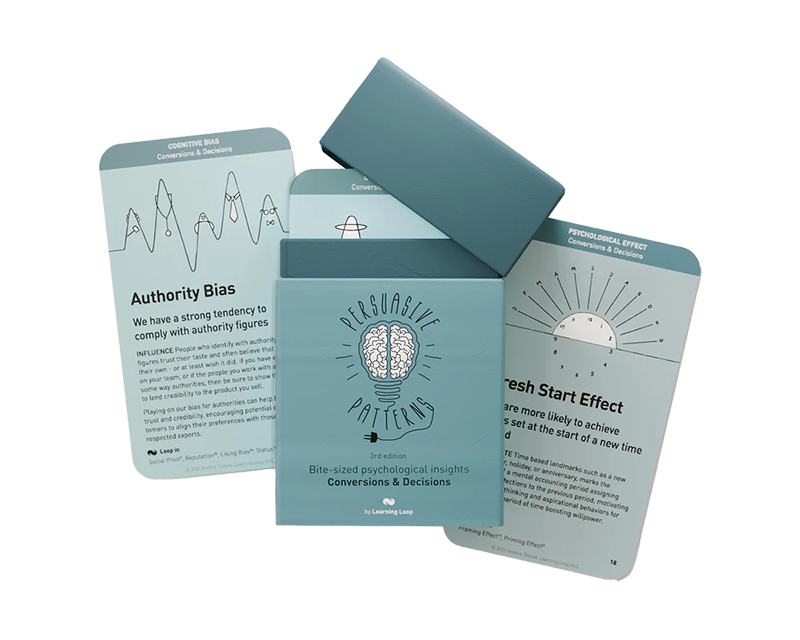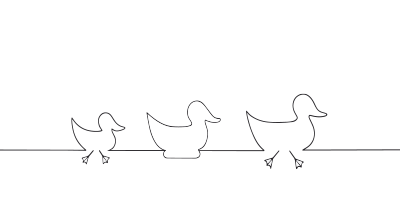
The Decoy Effect is a cognitive bias where consumers change their preference between two options when presented with a third option that is asymmetrically dominated. This third option is not intended to be chosen but to make one of the original options appear more attractive.
At a local bakery as you’re craving a sweet treat, but you’re also watching your calorie intake. Two options immediately catch your eye: a decadent chocolate cake and a healthy fruit tart. As you ponder these choices, a third option appears – a massive blueberry muffin piled high with sugary streusel. This seemingly unhealthier option, strategically placed by the baker, is the decoy. While it might not be your ideal choice, it makes the fruit tart suddenly seem like a sensible option compared to the overwhelming richness of the muffin.
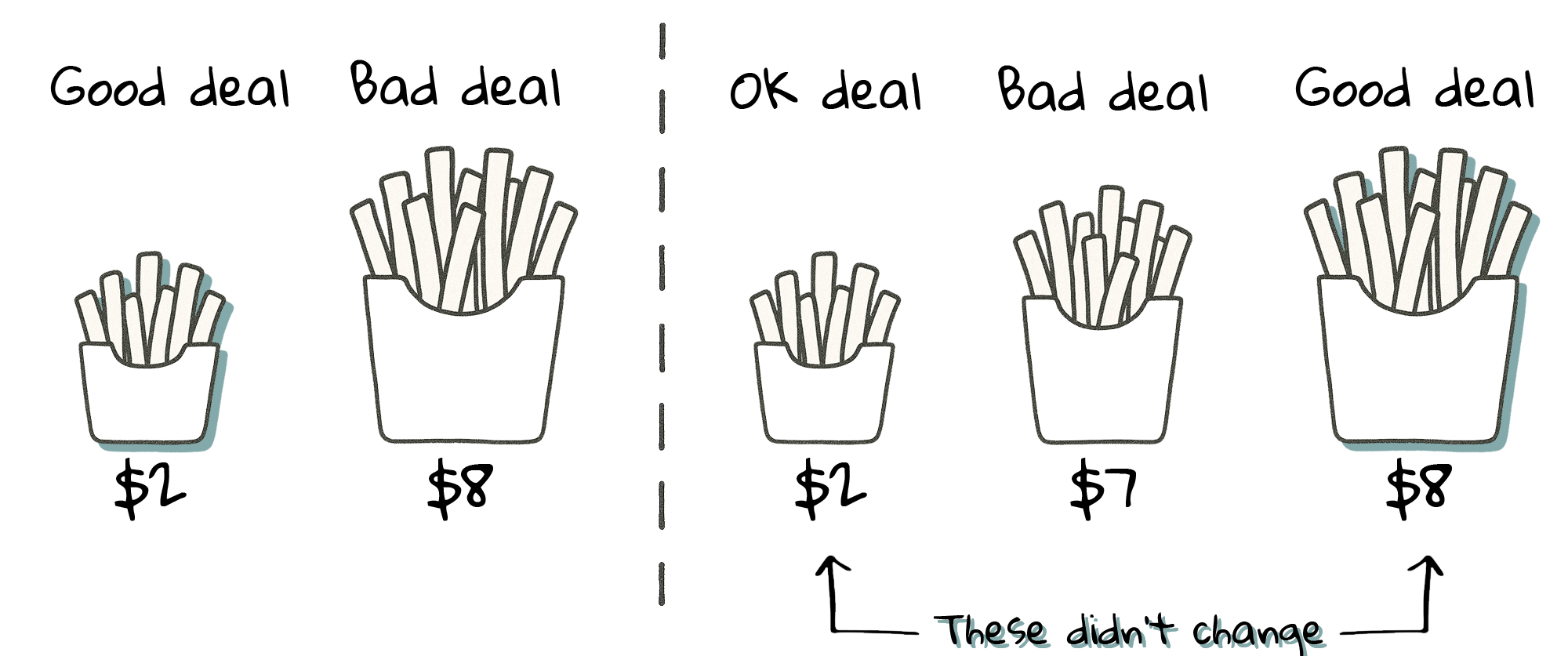
Similarly, a music streaming subscription service offers three options: a free tier with limited features and ads, a premium tier with ad-free listening, and a “premium plus” tier that includes ad-free listening, high-fidelity audio, and exclusive content. The “premium plus” option acts as the decoy here. While it might entice a small segment of audiophiles, for most users, it’s likely an excessive choice. However, its presence subtly positions the premium plan as the more reasonable option compared to the limitations of the free tier. This nudges users towards the premium subscription, aligning with the service’s business goals.
The study
One of the most influential studies illustrating the Decoy Effect was conducted by Dan Ariely, a renowned behavioral economist. His experiment, often referred to in discussions of consumer choice, involved subscriptions to “The Economist” magazine. Participants were presented with three subscription options: web-only for $59, print-only for $125, and a web and print combination for $125. The print-only option served as the decoy, making the combination option appear significantly more valuable since it was priced the same but included additional benefits. This setup dramatically shifted consumer preference towards the combination option, despite the web-only option being the most economical.
This experiment vividly demonstrates how adding a strategically inferior option (the decoy) can influence people to choose a more expensive or higher-margin item that otherwise might not have been their first choice.
Ariely, D. (2008). Predictably Irrational: The Hidden Forces That Shape Our Decisions. HarperCollins.
The Decoy Effect is primarily used to manipulate the decision-making process in such a way that guides consumers towards a preferred choice. The technique involves adding an option that is inferior in key aspects but similar to the targeted option, making the latter look more appealing in comparison. This effect is often leveraged in pricing strategies and product features to influence consumer behavior and increase the likelihood of choosing the more profitable or popular option.
The Decoy Effect hinges on a fundamental principle in human decision-making: our tendency to evaluate options relative to one another. This reliance on comparison points shapes our perception of value and influences our final choices.
The Decoy Effect is primarily rooted in the psychological principle of relative advantage and choice architecture. This effect illustrates how the presence of a third, less attractive option can influence decisions by making one of the original options seem more appealing in comparison. The psychological underpinnings of this effect are closely linked to the concepts of asymmetrical dominance and context-dependent choice.
Asymmetrical Dominance is a key behavioral principle influencing the Decoy Effect: we tend to have an easier time making a decision when they can clearly justify it. When a decoy is introduced that is similar but inferior to one of the options (asymmetrically dominated), it makes the better option stand out as the most advantageous, thereby increasing its attractiveness. This occurs because the decoy serves as a reference point that distorts perception—making the target choice appear superior not universally, but in the context of the available options.
The Decoy Effect also capitalizes on the context-dependent nature of human decision-making. Choices are not made in isolation but are heavily influenced by how they are presented and what comparisons are available. By manipulating these contexts, designers and marketers can steer preferences and influence the decision-making process. The addition of a decoy alters the context and shifts preference toward the target option by providing a clear rationale for the decision, thus reducing decision-making complexity and increasing confidence in the choice.
Underpinning this is the role of cognitive biases in decision-making. The Decoy Effect leverages biases such as the contrast effect—where the evaluation of an option changes when alongside less appealing alternatives—and the avoidance of regret. By positioning the target option as a more rational and beneficial choice, individuals are swayed towards it to avoid the potential regret of making a suboptimal choice.
When presented with multiple choices, we don’t evaluate them in isolation. Instead, we focus on specific attributes – like price, features, or benefits – and compare them across options. The decoy, strategically designed with specific attributes, serves as a reference point, influencing how we perceive the target option. For instance, in the phone plan example, the 1GB data plan for $50 acts as a decoy. While unlikely to be chosen itself, it highlights the seemingly better value proposition of the mid-priced plan with 2GB data for $40 compared to the unlimited data option.
Our attention is drawn to options that stand out from the rest. The decoy, often designed to be visually distinct or oddly priced, can capture our attention and influence our decision-making process. This salience can make the target option appear more moderate or reasonable by comparison.
Designing products with the Decoy Effect
The Decoy Effect offers a powerful tool for influencing user decisions in product design. By being strategic about how you present options, you can nudge users towards preferred choices while enhancing user experience and perceived value. Here’s a breakdown of key practical considerations.
Before crafting a decoy, step into your target audience’s shoes. What are their preferences and pain points? This insight is crucial for designing a decoy that resonates with them and effectively highlights the target option’s value.
An effective decoy should seem comparable to the target option, facilitating easy comparison, yet falls short in crucial aspects. Imagine selling subscriptions – a cleverly designed decoy plan might have a price close to the premium option but with fewer features. This positions the premium option as the more attractive choice.
While the decoy adds a layer of complexity, aim for overall simplicity. Don’t overwhelm users with excessive options. Ideally, limit choices to three: a clear winner (target), a decoy strategically positioned to make it stand out, and a less desirable option.
Let comparison be easy and transparent as you present options to chose from - especially in pricing or feature comparisons. Use straightforward language and visual aids like comparison charts to ensure users understand the distinctions between options and build trust.
The ideal decoy scenario involves three choices: target, competitor, and decoy. To be effective, the decoy must be asymmetrically dominated by the target and the competitor. In other words, the target should rate better than the decoy on all parameters (better on both A and B), where the competitor is only better than the decoy on a few parameters (better on A, but worse on B).
Other practical considerations include:
- Using decoys for good as a decision overload defense
The more options we have, the more difficulty we have making a decision (paradox of choice) and the more regret we have making the “wrong choice”. By manipulating what we focus on to make a decision and providing justification for our choices, the decoy effect can help us feel less anxiety from having too many options to choose from. - Decoys act as a new reference point for loss
According to the theory of Loss Aversion, it is more unpleasant to lose $10 than it is pleasant to gain $10. Loss aversion causes us to direct more focus toward the disadvantages when making decisions. What constitutes a loss and a gain is not set in stone and is defined relative to some reference point, why decoy options can partially function by manipulating where the reference point is, changing what is perceived as a loss and what is perceived as a gain.
People evaluate options in context. By understanding how the Decoy Effect shapes user behavior, you can create a user experience that guides decisions effectively while maintaining user trust and satisfaction. Remember, the goal is to provide clear value propositions with the decoy subtly nudging users towards the target choice.
Adding decoys is a powerful strategy to sway decisions toward a preferred option, so use the tactic ethically. The decoy should add value to the user experience rather than manipulate users into choices that don’t benefit them.
Ethical recommendations
The Decoy Effect, while a powerful tool, comes with ethical considerations that designers must be mindful of. Unethical use can manipulate users and erode trust.
A poorly designed decoy can be misleading. An excessively inferior option might discourage users from even considering the target option, hindering genuine choice. Similarly, a decoy priced significantly higher than the target can make the target seem cheaper than its true value.
The Decoy Effect leverages psychological biases like Loss Aversion. Unethical use could exploit these biases excessively, pressuring users into choices that don’t align with their true needs. For instance, a service might highlight the potential “loss” of features by not choosing a premium option, creating a false sense of urgency or inadequacy.
The effectiveness of the Decoy Effect relies on believability. A decoy that feels inauthentic or manipulative can backfire. Decoy options should feel like genuine choices, not artificial attempts to nudge users.
The misuse of the Decoy Effect arises primarily when companies deliberately design product options to manipulate customers into making decisions that may not align with their best interests. For example, creating a decoy that significantly overstates the value of the target product can lead to buyer’s remorse and a perception of deceit when customers realize the disparity between perceived and actual value. Such practices can erode trust and damage long-term brand relationships.
To ensure that the Decoy Effect is used ethically and remains customer-centric, businesses should adhere to the following best practices:
- Be transparent
Clearly communicate the differences between product options. Avoid hiding the flaws or drawbacks of the decoy; instead, present all choices objectively to help customers make informed decisions. - Be fair in your pricing
Ensure that the pricing strategy, while designed to guide choices, reflects genuine value. Avoid setting unrealistic prices for decoys to artificially inflate the appeal of the target option. - Focus on customer benefits
Design decoys that not only guide consumer choice but also offer real benefits. Each option should hold value, ensuring that no matter the choice, the customer gains a positive outcome. - Avoid exploitation
Be cautious not to exploit customers’ cognitive biases excessively. The goal should be to facilitate better decision-making, not to capitalize on psychological vulnerabilities. - Adhere to a set of ethical guidelines
Develop and adhere to ethical guidelines that govern the use of psychological tactics like the Decoy Effect. Ensure all marketing and design teams are aware of these guidelines and understand the importance of ethical considerations.
Real life Decoy Effect examples
iPhone pricing
Apple often uses the Decoy Effect in its pricing strategy by presenting older models at slightly reduced prices alongside newer, slightly more expensive models with significantly better features. This setup encourages customers to opt for the newer model, perceiving it as better value for a small price increase.
Movie Theater Concessions
Cinemas commonly use the Decoy Effect in their pricing of snack sizes. By pricing a small popcorn close to a medium but with significantly less popcorn, customers are more likely to buy the medium size, seeing it as a better deal.
Economist
One of the most cited examples of the Decoy Effect is the Economist magazine’s subscription model. They offered three subscriptions: web only, print only, and a combination of web and print. The print-only option was priced the same as the combination option, making the combination appear more valuable and increasing its sales.
Trigger Questions
- What is the target option we want users to choose?
- What are the key attributes users value in our product/service?
- Can we create a decoy option slightly inferior on these attributes?
- How can we visually distinguish the decoy without overpowering the target?
- Is the decoy priced strategically to nudge users towards the target?
- Does the overall choice architecture remain clear and transparent?
- Are our decoy options clearly inferior to the target choice but still plausible as a viable choice?
- Do we provide enough value in the preferred option to justify its cost compared to the decoy?
- How do we ensure that the introduction of a decoy does not complicate the decision-making process unnecessarily?
- Are we maintaining ethical standards by ensuring the decoy adds real choice and does not exploit customer biases?
Pairings
Decoy Effect + Anchoring Bias
The Anchoring Bias occurs when individuals rely too heavily on the first piece of information offered (the “anchor”) when making decisions. Pairing the Decoy Effect with Anchoring Bias can lead customers to perceive the anchor as a better deal, especially when the decoy makes the anchor appear more reasonable in price or value.

Create a new option that is easy to discard
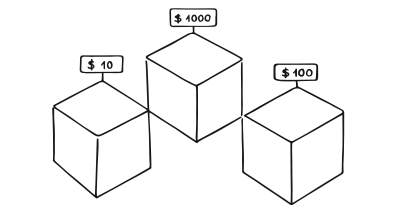
We tend to rely too heavily on the first information presented
Decoy Effect + Framing Effect
By presenting choices in a way that highlights the positive attributes of the target option compared to the decoy, the framing effect can manipulate the context to make one option seem more beneficial than another. This enhances the effectiveness of the Decoy Effect by shaping perception through positive framing.

Create a new option that is easy to discard

The way a fact is presented greatly alters our judgment and decisions
Decoy Effect + Scarcity Bias
Introducing a decoy as a limited-time offer can make the target option seem more desirable due to its availability. This exploits the scarcity bias, where people place higher value on products that are perceived as scarce or in limited supply.

Create a new option that is easy to discard
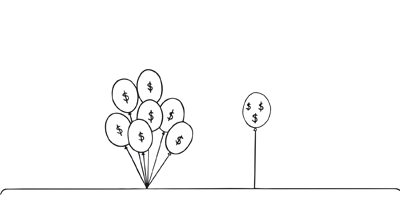
We value something more when it is in short supply
Decoy Effect + Loss Aversion
Loss Aversion suggests that people prefer to avoid losses rather than acquiring equivalent gains. When a decoy option underscores what could be lost by not choosing the superior option, it leverages loss aversion to push customers towards the target choice.

Create a new option that is easy to discard
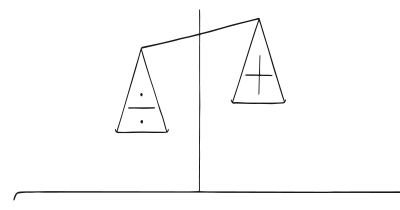
Our fear of losing motivates us more than the prospect of gaining
Decoy Effect + Endowment Effect + IKEA Effect
The Endowment Effect occurs when individuals value an item more highly simply because they own it. By allowing customers to customize or partly create a product (triggering the IKEA Effect), and positioning a decoy that enhances the value of their creation, companies can deepen the customer’s attachment to the chosen product.

Create a new option that is easy to discard
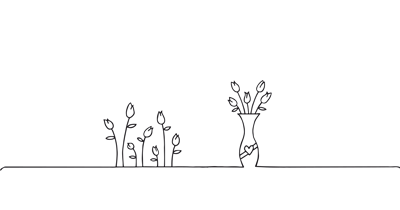
We value objects more once we feel we own them

We place a disproportionately high value on products we helped create
Decoy Effect + Social Proof
Imagine an e-commerce site showcasing a new phone with three options: basic, standard (target), and premium. The “standard” option boasts positive user reviews alongside a strategically priced decoy with slightly lower specs and no reviews. This taps into social proof (positive reviews) while the decoy subtly positions the standard option as the more trustworthy choice.

Create a new option that is easy to discard

We assume the actions of others in new or unfamiliar situations
Decoy Effect + Reciprocity
In the context of the Decoy Effect, offering a small concession or bonus with the target product can be perceived as a reciprocal gesture, encouraging customers to choose it over the decoy. For instance, providing free shipping or a small gift with the purchase of the target option enhances its attractiveness.

Create a new option that is easy to discard
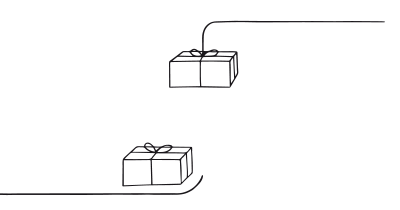
We feel obliged to give when we receive
Decoy Effect + Default Effect
Often, people will stick with pre-selected options. Pairing the Decoy Effect with setting the target option as the default choice can subtly nudge consumers towards it. Since the decoy is easily discarded, the default setting further simplifies the decision-making process, steering preferences towards the target.

Create a new option that is easy to discard

We are more likely to choose a pre-selected option
Decoy Effect + Limited Choice
A restaurant offers three meal sizes: small, medium (target), and large. The “medium” option is the most popular and profitable. The decoy could be a “Snack” size, appealing to those with smaller appetites. By limiting choices to three and introducing the “Snack” option, users are more likely to perceive the “medium” size as the standard and most logical choice.

Create a new option that is easy to discard
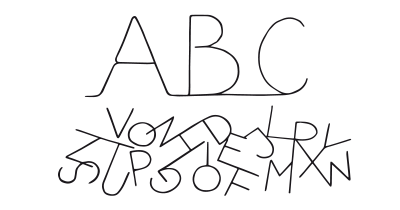
We are more likely to make a decision with fewer options to choose from
A brainstorming tool packed with tactics from psychology that will help you increase conversions and drive decisions. presented in a manner easily referenced and used as a brainstorming tool.
Get your deck!- Adding asymmetrically dominated alternatives by Huber, Payne & Puto
- Decoy Effect at The Decision Lab
- Decoy effect at Wikipedia (en)
- Ariely, D. (2008). Predictably Irrational: The Hidden Forces That Shape Our Decisions. HarperCollins.
- Iyengar, S. S., & Schwartz, B. (2004). How choice affects and limits satisfaction. Journal of Personality and Social Psychology, 86(2), 349-370.
- Huber, J., Payne, J. W., & Puto, C. (1982). Adding options: Decoy effects in decision making. Journal of Consumer Research, 9(1), 90-96.
- Roebuck, M., Bechara, A., & Lakshmanan, R. (2016). Decoy effects and the brain: Alleviating decision conflict through attribute-based processing. Journal of Consumer Psychology, 26(2), 202-213.
- Doyle, J. R., & O'Connor, D. J. (1999). The effect of the Decoy Effect on preferences between models. Journal of Marketing Research, 36(2), 299-308.
- Wedell, D. H., & Pettibone, J. C. (1996). Changing preferences through the Decoy Effect: The role of inconsistency and trade-off contrasts. Journal of Personality and Social Psychology, 71(3), 588-600.
- Kahneman, D., & Tversky, A. (1979). Prospect Theory: An Analysis of Decision under Risk. Econometrica, 47(2), 263-291.
- Payne, J. W., Bettman, J. R., & Johnson, E. J. (1993). The Adaptive Decision Maker. Cambridge University Press.
- Cialdini, R. B. (2001). Influence: Science and Practice. Allyn & Bacon.
- Hiebert, P. (2014, December 18). The paradox of choice, 10 years later. Pacific Standard.
- Chernev, A., Böckenholt, U., & Goodman, J. (2015). Choice overload: A conceptual review and meta-analysis. Journal of Consumer Psychology, 25(2), 333-358.
- Bateman, I. J., Munro, A., & Poe, G. L. (2008). Decoy effects in choice experiments and contingent valuation: Asymmetric dominance. Land Economics, 84(1), 115-127.
- Simonson, I. (1989). Choice based on reasons: The case of attraction and compromise effects. Journal of Consumer Research, 16(2), 158-174.
- Slaughter, J. E., Bagger, J., & Li, A. (2006). Context effects on group-based employee selection decisions. Organizational Behavior and Human Decision Processes, 100(1), 47-59.
- Stoffel, S. T., Yang, J., Vlaev, I., & von Wagner, C. (2019). Testing the decoy effect to increase interest in colorectal cancer screening. PLOS ONE, 14(3), e0213668.
